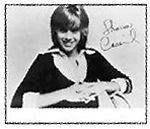CHAMELEONS UK
THE LONG WINTERS, SPYGLASS
Showbox, 206-628-3151, $15 adv.
9 p.m. Tues., Oct. 15
THE CHAMELEONS UK can still make me smile.
If you’ve ever heard the band, this admission may strike you as peculiar. Fans of the Chameleons (who, like many British groups in the ’80s, had to tack “UK” onto their moniker to avoid confusion with a lesser-known American act) typically fall into the same glad-to-be-unhappy camp that have kept Echo and the Bunnymen and the Cure in Aqua Net and eyeliner for two decades. But despite their affiliations with the trench coat mafia, I have long associated the Manchester quartet with one of the happiest periods of my life.
In late August 1985, with “In Between Days” fresh in my ears and high school behind me, I set off to start my new life at a Midwestern college. As I cruised down the highway, I popped in a fresh mix tape from my ex-boyfriend. Side one was dominated by summery selections from Style Council and Everything but the Girl. But the second half was dedicated to an unknown group my former paramour had been praising since before graduation: the Chameleons.
That afternoon, I didn’t yet know the names of these dark, cathartic songs—”Looking Inwardly,” “P.S. Goodbye,” “Home Is Where the Heart Is”—or the albums they’d been lifted from—Script of the Bridge and What Does Anything Mean? Basically. But in the months that followed, the Chameleons side of that cassette frequently provided the soundtrack for my unsupervised antics as a young adult. As my new cabal of black-clad friends and I planned the dazzling artistic coups we’d stage to shock our staid professors, we would commiserate with singer-bassist Mark “Birdy” Burgess’ somber lyrics and wallow in the mesmerizing, effects-laden guitar lines of Dave Fielding and Reg Smithies.
The following year, I moved off campus, and the Chameleons released their melancholy masterpiece, 1986’s Strange Times. On “Tears,”—a piece about Burgess’ loss of a friend to cancer—Fielding and Smithies spun guitar arpeggios into a single song as captivating as the entirety of Love and Rockets’ debut LP. The stately “Soul in Isolation,” with its final howls of “I’m alive in here,” made Ian Curtis seem as detached as Karen Carpenter. And “Swamp Thing,” the lead track on the second side, boasted a chorus as catchy—and a far sight less bombastic—than anything by frat boy-favorites U2.
But even with the major-label muscle of Geffen Records behind the band, Strange Times remained a cult item. In the image-driven U.K. press, the band’s lack of a cool look didn’t aid their cause. And the absence of a video clip for any of their singles meant MTV’s 120 Minutes promoted whinging hair-hoppers like Flesh for Lulu instead. A year later, following the death of their manager, the Chameleons split up.
Fifteen years later, with minimal fanfare, the original lineup buried the hatchet and released a fourth proper studio album, Why Call It Anything?. Now, I’m the first to bitch when defunct bands from the Reagan era hit the nostalgia circuit. I don’t know what all the answers to the world’s myriad ills are, but I’m certain a new Berlin album isn’t among them. But occasionally, there is an exception—like Soft Cell’s recent Cruelty Without Beauty—that makes the rule. Considering all the fanfare that recent comebacks by New Order and Echo and the Bunnymen have garnered, surely the Chameleons deserve a second chance.
Why Call It Anything? isn’t quite equal in theatrical punch to the Chameleons’ previous work—even though it reunites the quartet with Strange Times producer Dave Allen—but it still possesses its own charm. While the passing of years often forces singers into a lower register, Burgess’ voice now sounds higher and lighter than before, which complements the romantic leanings of numbers like “Anyone Alive?” perfectly. The band’s signature guitar sound, which would later prompt many Chameleons fans to follow the equally underrated Kitchens of Distinction (and, one suspects, didn’t escape the young ears of Interpol, either), still resonates majestically through tracks like “Truth Isn’t Truth Anymore.” As for the reggae inflections that pepper “Miracles and Wonders,” well . . . at least it comes at the album’s end.
I won’t lie. Even though I’m involved now in just as many harebrained creative projects as in my halcyon college days (although, alas, my folks aren’t picking up the tab anymore), and a Bush is back in the White House, Why Call It Anything? doesn’t bring me the same visceral joy that Strange Times or Script of the Bridge still do. But just the fact that the Chameleons are back, touring North America without big-label support, and playing selections from their entire catalog is enough to bring a smile to my face.
I just pray Flesh for Lulu don’t follow their example.







